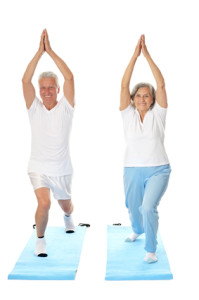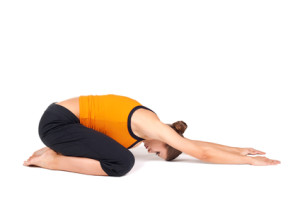Multiple sclerosis (MS) is a chronic disease that damages the nerves in the brain and spinal cord. Sclerosis means scarring; MS sufferers develop scar tissue in response to the nerve damage. Symptoms can include failure of muscle control, balance, vision, and even speech, depending on where the “flare ups” occur. Early MS symptoms include weakness, tingling, numbness, and blurred vision. Muscle stiffness and urinary problems are other signs as well. Treatment can relieve MS symptoms and delay progression, but there is no cure as of yet for MS.
So how can yoga help sufferers of MS?
According to experts, yoga – with its emphasis on relaxation: breathing, stretching  and deliberate movements – can do wonders for those afflicted with MS.
and deliberate movements – can do wonders for those afflicted with MS.
Yoga poses put the body in twists and unusual positions, training the proprioceptors in muscles and tendons to be more reactive. The muscle fibers located around the joints sense and accommodate for weight shifts. Having a greater awareness of body in space and in motion improves overall endurance and performance.
For a person with MS, practicing the postures for even 10 minutes allows the brain to function and focus on the task at hand, mastering the art of breath and these restorative positions. Yoga postures reduce the hormonal “fight or flight” response of the adrenals and give you a better sense of calmness. This calmer sense of purpose, or being present, can relieve stress and anxiety that can often be associated with chronic illnesses such as MS. When you have to deal with a disease day in and day out, it’s important to have some sort of defined stress relieving practice that you can do regularly to keep it at bay.
In a recent study, people with MS who practiced yoga experienced, among other effects, a reduction in MS-related fatigue and depression. Further studies prove that practicing yoga asanas (postures), meditation or combination of the two, reduced pain for people with MS conditions, as well as cancer, auto-immune diseases and hypertension, as well as arthritis, back and neck pan, and other chronic conditions.
For people with MS, stretching each morning is extremely important. Fluid motions of the body can get you ready for all the movement needed in the day ahead. Yoga helps you to live in your body more comfortably, improving flexibility and mobility, increasing range of movement and reducing aches and pains. While yoga cannot cure MS, it can teach you, through its postures and breathing, how to focus your mind and pay attention to your body.
Which type of yoga is best for people with MS?
There are many different styles of yoga. The physical practice of yoga is known as Hatha, which means to move with force. When you see hatha yoga on a schedule in America it tends to mean the class is more gentle movement. These classes will have the following core principles:
- Poses and breathing techniques are used to focus the mind on the body
 and breath
and breath - Each pose can be modified to suit your needs, making it a non-competitive environment
- Huge focus on alignment, which benefits posture and balance
- Yoga educates you about where muscles are and how to strengthen and stretch them
- Releases tension so the body feels more energized
- Relaxation techniques like deep breathing and clearing the mind are used to reduce stress and depression
Some practices emphasize alignment and long holding poses while others run positions together in sequences (Flow and vinyasa). Some are meant to be aerobic; others place focus more on meditation.
For people with MS, Yoga is highly recommended, as Yoga instructors are trained and skilled in creating classes that focus on proper alignment, deeper breathing, and providing modifications for individual needs. Restorative or slower paced vinyasa (flow) are both good choices. Hot yoga is not recommended. The hot room temperature can actually be dangerous for people with MS. A regular appropriate yoga practice will improve balance and range of motion within the joints, and also improve outlook on life. Studies have shown that those with MS were able to take on each day with newfound energy and positivity in coping with the disease with a regular yoga practice.
Here are some other tips for MS sufferers beginning a yoga practice:
- Start slowly. Talk with your instructor about your disability and how to adapt the stretches and postures to your abilities. Start out taking gentle yoga classes for beginners or for seniors.
- Be consistent with your practice. Try to practice yoga at least once a week. If you practice yoga twice a week, you might begin to see changes. Three times a week is ideal. No doubt you’ll notice a difference.
- Choose a class nearby. If you have to travel a far distance, it makes going to yoga discouraging.
Yoga for MS sufferers is encouraged. Learn to ask questions in class and don’t assume a pose or practice is right or not right for you – it’s better to have as much information as possible to stay safe.
Sources:
National Multiple Sclerosis Society
WebMD
MS Active Source
Kristy Manuel is a YogaFit Senior Master Trainer and Director of the YogaFit Therapy Program. She is an experienced yoga teacher, certified fitness trainer and wellness specialist with over 25 years experience in the fitness industry.
